by Mark TenBroek,
Sedona, AZ –Executive Summary
This proposed plan is intended to be actionable with specific elements to help with the effective management of Sedona area tourism. A first tenet of this plan is to identify and address the root causes of problems that Sedona is experiencing, not just treat the symptoms.
Residents, and businesses to a large extent, are primarily concerned with traffic congestion and the resulting overuse and degradation of the environment that takes place during peak visitation periods. Most seem to think there is no way to effectively control visitation during these peak periods and that we therefore need to find ways to mitigate the impacts. For example, the current SIM plan works on improving the efficiency of the constrained transportation system with expensive projects such as the Uptown median and northbound lane additions, the Forest Road extension, the parking garage, and the Brewer Road roundabout.
This approach is one of optimizing the existing street network. Others have suggested construction of bypasses, adding lanes, and similar approaches. However, a more basic question is why are there so many vehicles in town during peak periods? Will this frequent gridlock eventually give Sedona bad (or worse) press in all media channels? How will that impact visitation and the experience of those that do come?
We need to ask ourselves why are there so many visitors during peak periods and how could we encourage them to better plan their visitation times so that they will impact the community less while still maintaining a healthy business economy.
It is no surprise that I am suggesting that the root cause of the congestion is the almost unlimited access to the hiking trails in and around Sedona. Other reasons for more visitation include the increasing numbers of Short Term Rentals and the impact of social media to draw people to Sedona. Ultimately, it is the unlimited access to the trail system that draws an increasing number of visitors to Sedona.
I would suggest that the following actions that would SOLVE or dramatically reduce this congestion problem:
- Eliminate existing roadside parking near trailheads.
- Place the remaining parking lot access points on a reservation system.
- Move the Cathedral Rock trailhead from Back O’Beyond onto Forest Service land.
- Limit public parking, implement a robust parking guidance system not just in Uptown but community wide, and use variable parking rates at all locations.
- Use transit and trailhead reservations to encourage traditional lodging use and provide service up canyon during the hot summer periods.
- Aggressively move to buildout a safe multi-modal trail system throughout Sedona and to trailheads.
All these steps recognize that this is not just a Sedona issue, but one that includes multiple jurisdictions in the Verde Valley. For the 6 steps to work, requires the following:
- Cooperation between Sedona, Yavapai and Coconino Counties, Arizona State Parks, and the USFS.
- Funding for changes to parking and transit.
- Funding for enforcement of these restrictions.
- Political will to address this problem comprehensively.
 Following is a discussion of each of these changes, why they would work, and some roadblocks that need to be addressed prior to their implementation:
Following is a discussion of each of these changes, why they would work, and some roadblocks that need to be addressed prior to their implementation:
Eliminate Roadside Parking near Trailheads
It is important to understand that visitors come to Sedona for many reasons, but likely the most impactful is that according to a 2018 Chamber survey 72% of visitors come to town to hike iconic trails in or near Sedona. Cathedral Rock, Bell Rock, Soldiers Pass, Devil’s Bridge, Boynton Canyon & Secret Subway, Birthing Cave, and many others draw people to our community. The USFS has set up trailhead parking areas for these trails that are sized to provide appropriate access, but also to manage the visitation levels to each of these hiking areas so that the impact on the Coconino National Forest is managed and sustainable.
Prior to the construction of the SR-179 Scenic Byway the roadway between the Village of Oak Creek and Sedona had many pull off and social parking locations besides the official parking areas. The implementation of a curbed roadway and parking limitations has dramatically improved this area with trailhead use limited to and passively managed by the available parking spaces.
A similar approach has been moving forward up Oak Creek Canyon with many of the informal pullouts and parking areas eliminated, which has reduced the available unofficial parking and reduced the safety problems.
The “wild west” areas that remain near our community are the uncontrolled parking along Dry Creek Road, Long Canyon Road, and Boynton Pass Road out to Doe Mountain trailhead. The available informal roadside parking in these areas is easily 10 times the official parking in this part of the Coconino National Forest. This has led to much heavier than sustainable hiker density, trash issues, and damage to the trails. This is not sustainable use of these areas of the National Forest, and it also causes hiker auto congestion in Sedona during peak periods.
Sedona staff and City Council has long recognized this problem and has installed boulders within the City limits and has been working with Yavapai County and the USFS to eliminate parking in the remaining roadside parking areas shown in the attached figure. Yet, there remains significant excessive roadside parking in Yavapai County. While Sedona is the most impacted by this overuse which results in more visitors during these peak periods, management of roadside parking in these areas is controlled by other governmental units. Funding is needed to address these issues and intergovernmental cooperation is needed. It is essential that agreements are reached between these governmental units and the necessary parking limitations and enforcement is provided.
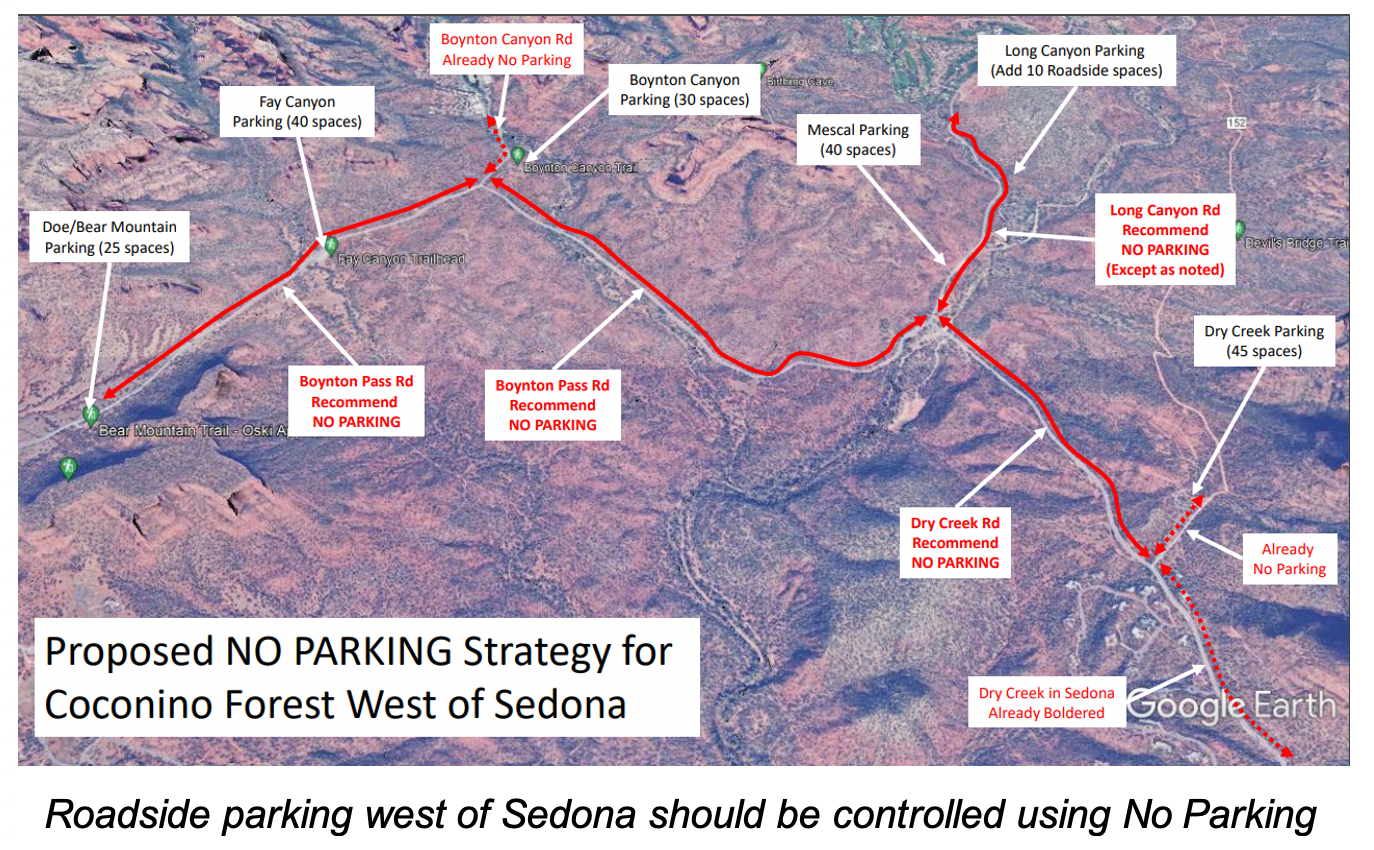
This elimination of roadside parking is essential to controlling the number of hikers on these trails, and frankly the number of visitors driving through Sedona during peak periods.
Place the remaining parking lot access points on a reservation system
The USFS has established and sized trailhead parking lots to accommodate the number of hikers that they believe will not degrade the trails they serve. This is a sensible goal, but can lead to congestion at the parking lots with potential hikers circling the lots waiting for a space to clear.
The Forest Service has taken a different approach at Fossil Creek. Given the sensitive nature of that area, they have implemented a reservation based system to control the number, timing, and locations of parking for hikers that visit this sensitive area. This system can be viewed at this link: Fossil Creek. For a fee this site allows users to request a date and time for access that guarantees them access to a particular lot, and more importantly, controls the number of hikers to this gem. The fee also pays for the enforcement of this system during peak usage periods.
This reservation system has been applied to Fossil Creek during peak use periods and provides a more manageable and enjoyable experience for hikers. A similar paid reservation system has long been employed at North Coyote Buttes in northern Arizona and more recently in several National Parks including Arches and Yosemite. Ignoring the overuse aspect of public lands can no longer be justified.
An example of how effective a reservation system can be might be Quandary Peak trail in Summit County, Colorado that leads to one of the most accessible 14er summits in that state. In 1980 my party of four hiked this 6 mile out and back route over about 6 hours. While it was a weekend, no other hikers were on the trail. In 2020, over an estimated 40,000 hikers summited on this trail, an average of over 100 per day, with peak days in the hundreds.
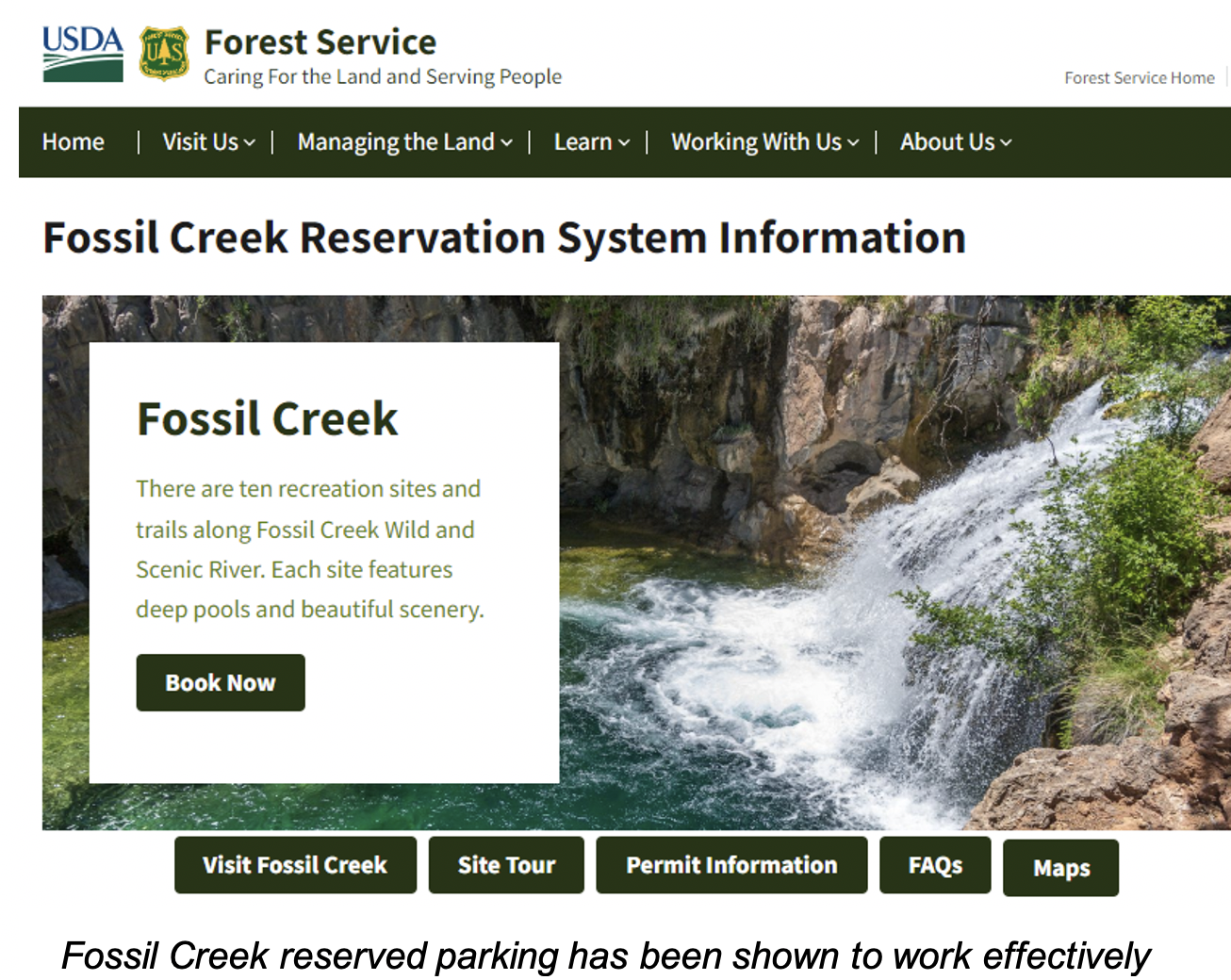
Given the increasing trail damage, trash, and other issues Summit County implemented a roadside parking ban and a scheduled parking reservation system with parking times and durations during peak months that included a parking fee and required the permit be displayed on the dashboard. Last year, this simple system reduced the annual hikers to 14,000, or a third of previous years. By all accounts, a much better experience and a more sustainable trail system for users.
Requiring peak period parking reservations for all or selected Sedona trailheads could also reduce visitation damage to Sedona trails, improve the visitor experience, and would also encourage visitors to plan their vacation timing to line up with reservation availability for the highly desired trails. This will help to even out the visitation in Sedona and reduce traffic congestion in Sedona.
Move the Cathedral Rock trailhead out of Back O’Beyond and onto Forest Service Land
Along SR-179 the trail to Cathedral Rock remains one of the highest use hikes in Sedona. Unfortunately, the trailhead, established before Sedona was incorporated, is located on a narrow Sedona public roadway that does not properly serve the hiker numbers. This has resulted in illegal parking, pedestrians walking down the middle of the roadway, and conflicts with local residents. The City tried to work with the Forest Service to develop a new trailhead for hiker access on Forest Service land just to the south, but has not yet been able to convince the Forest Service to move forward with that plan in spite of offering funding for the project.
As a result, the community needed to act to resolve these safety issues and now operates a trailhead transit operation that moves hikers from a lot located along SR-179 to the trailhead during weekends and other peak visitation periods. This is expensive and also requires Traffic Control Assistants to man the parking lot and the Back O’Beyond access point year round.
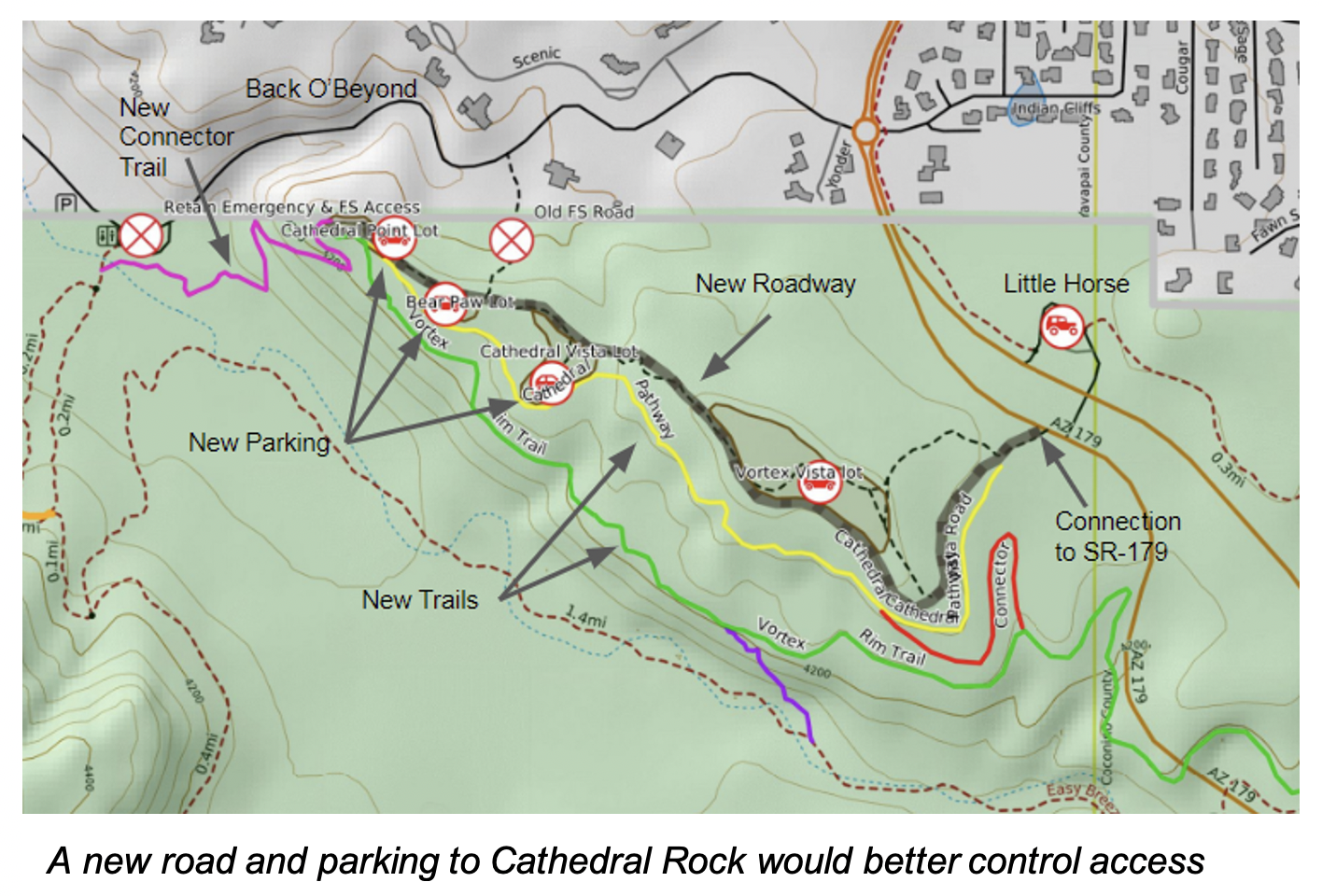
While this can be viewed as a success in resolving the safety issues of the trailhead parking on a low capacity roadway, it requires active management of the system year round, which is not ideal.
By moving the access to this trailhead to a new access roadway and parking lot on Forest Service land it would bring this trail in line with the other trailheads along SR-179. It would also allow the use of a parking reservation system to more passively manage use of the trail.
Limit public parking, implement a robust parking guidance system not just in Uptown but community wide, and use variable parking rates at all locations
The recent review of the parking garage in Uptown has led to visioning what public parking should be in Uptown. The whole idea of public parking and its use needs to be better understood and controlled. This discussion identified several needed items:
- A Parking Guidance System that actively determines open parking spaces and directs those that need
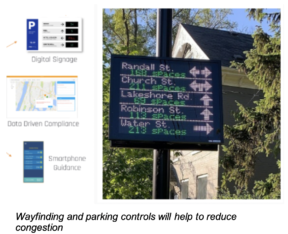 parking to them is needed in Uptown and elsewhere.
parking to them is needed in Uptown and elsewhere. - A system is needed to manage/transport the several hundred employees of Uptown who should not be using public parking intended for visitors. Transit may be needed to transport these employees into Uptown from outlying areas to maintain available public parking for Uptown visitors.
- Visitors (and employees) should not spill over and impact resident parking.
- Public parking needs to be self-funded with parking fees. While parking along 89A is currently paid parking, all public parking needs to include variable rate parking fees to pay for this resource. In addition, parking in private lots should be coordinated with public parking to avoid confusing visitors with a variety of parking management systems.
In summary, Public Parking throughout Sedona needs to be managed in a comprehensive manner and be self-funding.
Use transit to encourage traditional lodging use and provide service up canyon during hot summer periods
Currently all trailhead transit moves hikers from three different free public lots to a trailhead year round. Hikers must drive to these parking lots and then shuttle to the trailheads they serve. A new demand based transit system (micro-transit) will provide improved point to point service throughout much of Sedona. It would be helpful if those that are staying in traditional lodging could leave their vehicles in the hotel parking lot and have direct access to the trailheads using transit, either the demand based micro-transit or directly with the Trailhead Transit system.
The proposed trailhead parking reservation system discussed earlier could be applied to the Trailhead Transit and traditional lodging locations could be provided a fixed number of trailhead access reservations to encourage the use of traditional lodging in Sedona. This would keep cars in lodging parking during the day and increase the number of visitors using hotels in Sedona so they can hike the trails they want.
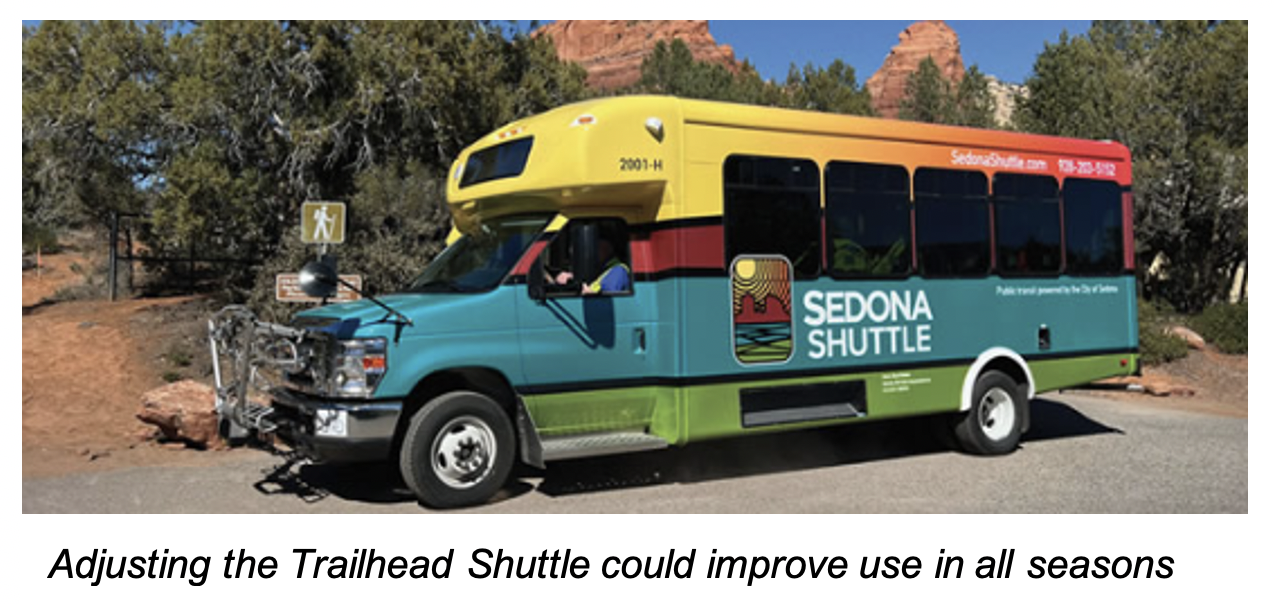
Secondarily, adjusting Trailhead Transit to provide access up Oak Creek Canyon during the hotter months (June, July, and August) when most red rock trails are not highly used and potentially unsafe, could also improve the advantage that traditional lodging has if they are given priority access to sought after Oak Creek Canyon trailheads such as Slide Rock, Grasshopper Point, and West Fork. These summer routes would need to charge a fee for this service and a portion of that fee would be transferred to the Oak Creek Canyon sites that they serve. This approach would also require cooperation between Sedona, the USFS and their concessionaires, and Arizona State Parks.
Aggressively move to provide a safe multi-modal trail system throughout Sedona and to trailheads
Many communities in the USA and abroad have been moving aggressively towards providing more walkable and bikeable streets and interconnected multimodal pathways. This strengthens communities, provides a health benefit, and reduces congestion. Sedona did not develop with a good walking or biking strategy and has many streets that are narrow and not particularly safe for these uses.
However, as part of the SIM work Sedona has been developing multi-modal pathways that are separated from other modes of transportation to benefit Sedona by helping to reduce the dependency on autos and would help reduce congestion by keeping people out of their autos for some trips. If it is faster and more pleasant to ride a bike than driving and finding a parking place, many would switch to this option if a safe pathway is provided. This is a common approach that is taken in many space limited and transportation constrained communities in Europe.
Sedona has the beginnings of a good multi-modal system, but to be really useful a safe, separated, continuous  bikeway between Uptown, along (or paralleling) 89A would dramatically improve our community and make it more accessible to residents and visitors alike, and would reduce overall congestion.
bikeway between Uptown, along (or paralleling) 89A would dramatically improve our community and make it more accessible to residents and visitors alike, and would reduce overall congestion.
Conclusion
Growth and continued development are not always the answer to community needs. Thinking strategically about how to manage peak visitation by controlling trail access during peak times will control visitor numbers and allow the existing constrained transportation system to operate more efficiently. It will also encourage visitors to come here during non-peak periods helping to make the local economy less peak and valley and more consistent. Win-win for businesses and residents alike

Mark is a retired Professional Civil Engineer who graduated from the University of Michigan in 1977 (Go Blue) and worked as a consulting and design engineer in the Midwest for over 40 years. He worked primarily on Water and Wastewater projects for municipalities and utilities. Mark and his spouse arrived in Sedona in 2017 to design and build a home in Uptown where they now live. He understands Sedona’s unique place as both a sacred and spiritual center. Researching how the local economy can be effectively managed to protect our quality of life, the natural world, the tourist

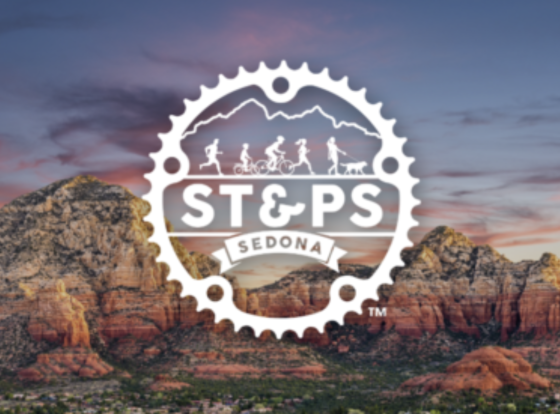




15 Comments
Well said. You should run for mayor. I hope the council takes the time to read this. Maybe they could learn something.
To their credit, the Mayor and City Council are aware and working on many of these items. In particular, the City has installed boulders on Dry Creek Road to the City limits, and has been working with Yavapai County and the USFS to establish No Parking for the remainder of those informal roadside parking areas. For the proposed USFS access road and parking on USFS land for Cathedral Rock, the City offered to fund the construction, but the USFS declined.
The City also built a new parking area at Posse Grounds and installed multi-use pathway to Soldiers Pass, which most hikers now use. Unfortunately the City needed to take the step of providing and funding the Trailhead Shuttle (at $1.4M per year) to mitigate safety issues at those two trailheads. Building a permanent solution to the Cathedral Rock trailhead would likely be better than the continued annual cost of the Trailhead Shuttle.
If the USFS had taken these steps, and if the reservation system for the remaining parking was instituted during peak periods, it could have a dramatic impact on reducing traffic congestion in Sedona and everyone would be much happier. Perhaps with a new Red Rock District ranger, it may be the time to lobby them to institute reservations for trailhead parking.
All highly used restaurants use reservation systems because they work. It also clearly works for Fossil Creek, so lets work to get this in place for the Red Rock district of the Coconino Forest.
What’s your plan for handicap access to Trailheads?
A reservation system for trailhead parking would work for those with and without handicaps. Clearly some locations are more appropriate for those with Handicaps.
The Chapel of the Holy Cross needs a reservation system too.
I think most residents that live in the Chapel area would agree. It might be useful to lobby the church for this change.
Ok and for residents who are handicapped would they need reservations to park at local trailheads or would there be resident handicapped parking available at all times? Or would all residents be required to make reservations to park at trailheads and hike in their own town?
I don’t expect to have an open table at Elote if I walk there and I don’t think many other residents expect this. I need to place a reservation like all their customers. For the trails in Sedona, residents would be no different than others that live in the USA, except we have more dates to choose from to place a reservation. We can also pick a non-reservation day to access any trailhead that requires a reservation.
When driving back from Cottonwood last Saturday during golden hour (5:30) I thought how fortunate I am to live here with Greyback, Coffeepot, and snow capped Wilson Mountain illuminated by the evening light and dark clouds behind. I had to text a friend when I got home to remark how beautiful it was and how all residents are stewards who need to do all we can to protect this wonderful place.
A reservation at a privately owned establishment is far far different than access to land that is meant to be accessible to all at all times.
I like the idea of reservation parking and I don’t. Just as I like making trails accessible to hikers but not bikers on say odd days and the reverse on even days but to have trails open to each every day seems appealing. But you will never satisfy everyone on any one solution. I’d like to say majority rules but we do not vote on such matters so that is out as well.
Limiting accessibility will also likely lead to more people driving and parking where it is prohibited damaging our already vulnerable ecosystem and more trash on the trails and at trailheads. Do you limit one’s hours at any given trailhead per reservation or is time unlimited? How would you regulate time for people who have annual or permanent handicap passes?
And lastly what about off season parking for residents when Sedona is empty of tourists? Would residents still require reservations?
Parking at trailheads is under Forest Service control not the City of Sedona’s so how would they verify residents being residents without the residents having to physically go to them and present an ID each and every time they wish to use a trailhead and that would be a major inconvenience. Decals or passes would need to be provided to residents annually in order for the “reserved” parking to be regulated properly and that would cost big $ right there.
Just saying more thought needs to be put into your outlined suggestions if they are to work and work properly.
Paul, thanks for your thoughts. It is hard to find a solution that solves all problems, but we can’t do nothing. My vision of a reservation system for trails is only at specific peak times – Spring Break, weekends, Thanksgiving, etc. Other times, the lot size manages usage. The Fossil Creek reservation has a specific lot and time that is displayed on the permit. The fee for use is to enforce the times at parking.
This system would depend on limiting roadside parking since if not, people will abuse and overuse and damage would result. So no reservations needed during the low use times.
As I noted, residents are not special and need to follow these same rules in National Forest land. And finally, I think that we need to incrementally work on these changes and adjust as needed to make it work as hoped. Remember, the “perfect is the enemy of good”.
A major problem, as much as traffic, is for us, the residents to be able to access our trails. It is much more difficult than it used to be. We cannot even bicycle to the trail head Soldiers Pass anymore because of the way they close the gate and limit the access of bicycles which is completely contradictory to the goals I would think.
I would agree that using a bicycle to navigate around Sedona is a huge advantage on high traffic days. A trailhead reservation system as I suggest would probably make it more accessible to those that bike as well.
I don’t understand this comment. There is a path around the gate at Soldier’s Pass lot. I’ve dropped people by car, drove to Posse Grounds to park and then rode a ten speed back to the trailhead (reversing that on the way out). Works great!
Thank you for a well- thought out article on how to help our local challenges.
Since moving here, I can no longer hike Cathedral without negotiating heavy traffic, waiting for a parking space, cramming onto a bus (and then reversing that process to get home!). I can no longer camp out in the desert. I cannot ride my e-bike on trails. I’ll never eat at Elotes again!
I’m all for permits, including permits to drive Oak Creek Canyon. I’m all for building a bridge across Oak Creek and only permitting locals to use it. I’m all for locals having designated parking spots, first access to permits, etc. Before you assume I’m a NIMBY, I understand people visiting this area. I know how lucky I am to live here. But I think our City Council needs to continue to put locals first while negotiating the current challenges. I feel the mayor does an amazing job at this.
Significant increases of peak tourism impacts all residents. I do think the Mayor and Council recognizes the needs of residents, and they are trying to think regionally as best they can.
Their establishment of the Tourism Advisory Board and severing the contract with the Chamber demonstrate how invested they are in working toward solutions. Cooperation with the other units of government is likely the best strategy, but this does take time and is incremental. We also need engaged residents who can help move forward. Thanks for being engaged!